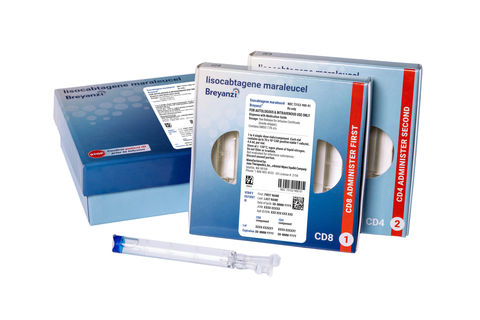Breyanzi offers a personalized treatment option delivered as a one-time infusion that provides deep and durable responses for patients with relapsed or refractory CLL or SLL who have historically had no standard of care
In TRANSCEND CLL 004, the first pivotal multicenter trial to evaluate a CAR T cell therapy in patients with relapsed or refractory CLL or SLL, 20% of patients treated with Breyanzi achieved a complete response (CR) with median duration of CR not reached, along with an established safety profile
Breyanzi is now FDA approved for relapsed or refractory large B-cell lymphoma and CLL or SLL, bringing this differentiated CD19-directed CAR T cell therapy to more patients
Bristol Myers Squibb (NYSE: BMY) today announced the U.S. Food and Drug Administration (FDA) has granted accelerated approval of Breyanzi® (lisocabtagene maraleucel; liso-cel), a CD19-directed chimeric antigen receptor (CAR) T cell therapy, for the treatment of adult patients with relapsed or refractory chronic lymphocytic leukemia (CLL) or small lymphocytic lymphoma (SLL) who have received at least two prior lines of therapy, including a Bruton tyrosine kinase (BTK) inhibitor and a B-cell lymphoma 2 (BCL-2) inhibitor. This indication is approved under accelerated approval based on response rate and duration of response. Continued approval for this indication may be contingent upon verification and description of clinical benefit in confirmatory trial(s). In R/R CLL or SLL, Breyanzi is delivered through a treatment process which culminates in a one-time infusion* with a single dose containing 90 to 110 x 106 CAR-positive viable T cells. Please see the Important Safety Information section below, including Boxed WARNINGS for Breyanzi regarding Cytokine Release Syndrome (CRS), Neurologic Toxicities, and Secondary Hematological Malignancies.
This press release features multimedia. View the full release here: https://www.businesswire.com/news/home/20240313169337/en/

Product image for download (Photo: Bristol Myers Squibb)
“CAR T cell therapies represent a transformative treatment option for patients with certain types of blood cancers,” said Bryan Campbell, senior vice president, Head of Commercial, Cell Therapy, Bristol Myers Squibb. “For years, attempts to bring other CAR T cell therapies to patients with relapsed or refractory CLL or SLL met challenges and found little success. With the approval of Breyanzi as the first CAR T for relapsed or refractory CLL or SLL, we are now able to offer these patients a personalized option, while further expanding access across the broadest array of B-cell malignancies, to address this critical unmet need.”
CLL and SLL are among the most common types of B-cell lymphoma. Treatments for people living with CLL or SLL primarily consist of targeted therapies including BTK- and BCL-2 inhibitors. However, patients often experience relapse or become refractory following early-line treatment with these therapies and there is no established standard of care for patients with double-class exposed CLL or SLL. After relapsing or becoming refractory to these therapies, patients have few options and poor outcomes, including lack of durable complete responses.
The Phase 1/2 open-label, single-arm TRANSCEND CLL 004 study was the first pivotal multicenter trial to evaluate a CAR T cell therapy in patients with relapsed or refractory CLL or SLL. The CR rate associated with Breyanzi treatment was 20% (95% CI: 11.1-31.8). Among patients who achieved a CR, median duration of response was not reached (95% CI: 15 months-NR) at the time of data cutoff. Among all responders (ORR = 45%; 95% CI: 32.3-57.5), median duration of response was 35.3 months (95% CI: 12.4-NR). High rates of minimal residual disease (MRD) negative status were observed across patients treated with Breyanzi who achieved a CR, with an MRD-negativity rate of 100% in the blood (95% CI: 75.3-100) and 92.3% in the bone marrow (95% CI: 64-99.8).
“CLL and SLL are currently considered incurable diseases with few treatment options in the relapsed setting that can confer complete responses, something that has historically been associated with improved long-term outcomes,” said Tanya Siddiqi, M.D., lead investigator and Associate Professor, Division of Lymphoma, City of Hope National Medical Center. “The FDA approval of liso-cel in relapsed or refractory CLL and SLL after treatment with prior BTKi and BCL2i is a remarkable breakthrough, shifting the treatment paradigm from continuous therapy with sequential regimens to overcome drug resistance, to a one-time personalized T-cell based approach that has the potential to offer patients complete and lasting remission.”
Among 89 patients in the study treated with Breyanzi, occurrences of cytokine release syndrome (CRS) and neurologic events (NEs) were mostly low grade. Any grade CRS occurred in 83% of patients, with Grade 3 CRS occurring in 9% of patients. No Grade 4/5 CRS events were reported. Any grade NEs were reported in 46% of patients, with Grade 3 NEs reported in 20% of patients and one case of Grade 4 NE reported. No Grade 5 NEs were reported.
“For people struggling with relapsed or refractory CLL or SLL, current treatment choices are limited,” said Dr. Brian Koffman, physician, CLL patient and cofounder, executive vice president and chief medical officer of CLL Society. “The approval of Breyanzi as the first CAR T cell therapy available for relapsed or refractory CLL or SLL brings new hope to these patients with the potential for durable responses after a single CAR T infusion. We are grateful to the patients and their families who enter the trials and to all the researchers involved in making possible this important new treatment option in CLL and SLL.”
Bristol Myers Squibb offers various programs and resources to address the needs of patients and caregivers, and provides support that allows for access to therapies, including Breyanzi. Bristol Myers Squibb also supports the patient and physician treatment experience by providing Cell Therapy 360, a digital service platform, which optimizes access to relevant information, manufacturing updates, and patient and caregiver support.
About TRANSCEND CLL 004
TRANSCEND CLL 004 (NCT03331198) is a Phase 1/2 open-label, single-arm, multicenter study evaluating Breyanzi in patients with relapsed or refractory chronic lymphocytic leukemia or small lymphocytic lymphoma. The Phase 1 dose escalation portion of the study assessed the safety and recommended dose for the subsequent Phase 2 expansion cohort. The Phase 2 portion of the study is evaluating Breyanzi at the recommended dose from the Phase 1 monotherapy arm. The primary endpoint of the Phase 2 portion of the study is complete response rate, including complete remission with incomplete bone marrow recovery, based on independent review committee according to the International Workshop on Chronic Lymphocytic Leukemia (iwCLL) 2018 guidelines.
About CLL and SLL
Chronic lymphocytic leukemia (CLL) is one of the most common types of leukemia in adults. In CLL, too many blood stem cells in the bone marrow become abnormal lymphocytes, and these abnormal cells have difficulty fighting infections. As the number of abnormal cells grows, there is less room for healthy white blood cells, red blood cells and platelets. Small lymphocytic lymphoma (SLL) also affects the lymphocytes, with cancer cells found mostly in the lymph nodes. While there are several treatments available for CLL and SLL, there is a need for additional effective therapies as there is no standard of care for relapsed or refractory CLL or SLL after prior therapy with targeted agents, such as Bruton tyrosine kinase (BTK) and B-cell lymphoma 2 (BCL-2) inhibitors. Patients with relapsed or refractory disease have limited treatment options and generally experience shorter periods of response with each subsequent treatment.
About Breyanzi
Breyanzi is a CD19-directed CAR T cell therapy with a 4-1BB costimulatory domain, which enhances the expansion and persistence of the CAR T cells. Breyanzi is made from a patient’s own T cells, which are collected and genetically reengineered to become CAR T cells that are then delivered via infusion as a one-time treatment.
Breyanzi is approved in the U.S., Japan and Europe for the second-line treatment of relapsed or refractory LBCL, and in Japan, Europe, Switzerland, and Canada for relapsed and refractory LBCL after two or more lines of systemic therapy. Bristol Myers Squibb’s clinical development program for Breyanzi includes clinical studies in other types of lymphoma. For more information, visit clinicaltrials.gov.
* Treatment process includes leukapheresis, manufacturing, administration, and adverse event monitoring.
Indication
BREYANZI is a CD19-directed genetically modified autologous T cell immunotherapy indicated for the treatment of:
-
adult patients with large B-cell lymphoma (LBCL), including diffuse large B-cell lymphoma (DLBCL) not otherwise specified (including DLBCL arising from indolent lymphoma), high-grade B cell lymphoma, primary mediastinal large B-cell lymphoma, and follicular lymphoma grade 3B, who have:
- refractory disease to first-line chemoimmunotherapy or relapse within 12 months of first-line chemoimmunotherapy; or
- refractory disease to first-line chemoimmunotherapy or relapse after first-line chemoimmunotherapy and are not eligible for hematopoietic stem cell transplantation (HSCT) due to comorbidities or age; or
- relapsed or refractory disease after two or more lines of systemic therapy.
Limitations of Use: BREYANZI is not indicated for the treatment of patients with primary central nervous system lymphoma.
- adult patients with relapsed or refractory chronic lymphocytic leukemia (CLL) or small lymphocytic lymphoma (SLL) who have received at least 2 prior lines of therapy, including a Bruton tyrosine kinase (BTK) inhibitor and a B-cell lymphoma 2 (BCL-2) inhibitor.
This indication is approved under accelerated approval based on response rate and duration of response. Continued approval for this indication may be contingent upon verification and description of clinical benefit in confirmatory trial(s).
Important Safety Information
WARNING: CYTOKINE RELEASE SYNDROME, NEUROLOGIC TOXICITIES, AND SECONDARY HEMATOLOGICAL MALIGNANCIES
- Cytokine Release Syndrome (CRS), including fatal or life-threatening reactions, occurred in patients receiving BREYANZI. Do not administer BREYANZI to patients with active infection or inflammatory disorders. Treat severe or life-threatening CRS with tocilizumab with or without corticosteroids.
- Neurologic toxicities, including fatal or life-threatening reactions, occurred in patients receiving BREYANZI, including concurrently with CRS, after CRS resolution or in the absence of CRS. Monitor for neurologic events after treatment with BREYANZI. Provide supportive care and/or corticosteroids as needed.
- T cell malignancies have occurred following treatment of hematologic malignancies with BCMA- and CD19-directed genetically modified autologous T cell immunotherapies, including BREYANZI.
- BREYANZI is available only through a restricted program under a Risk Evaluation and Mitigation Strategy (REMS) called the BREYANZI REMS.
Cytokine Release Syndrome
Cytokine release syndrome (CRS), including fatal or life-threatening reactions, occurred following treatment with BREYANZI. Among patients receiving BREYANZI for LBCL (N=418), CRS occurred in 46% (190/418), including ≥ Grade 3 CRS in 3.1% of patients. In patients receiving BREYANZI after two or more lines of therapy for LBCL, CRS occurred in 46% (122/268), including ≥ Grade 3 CRS in 4.1% of patients. One patient had fatal CRS and 2 had ongoing CRS at time of death. The median time to onset was 5 days (range: 1 to 15 days). CRS resolved in 98% with a median duration of 5 days (range: 1 to 17 days). In patients receiving BREYANZI after one line of therapy for LBCL, CRS occurred in 45% (68/150), including Grade 3 CRS in 1.3% of patients. The median time to onset was 4 days (range: 1 to 63 days). CRS resolved in all patients with a median duration of 4 days (range: 1 to 16 days).
Among patients receiving BREYANZI for CLL/SLL, CRS occurred in 83% (74/89), including Grade 3 CRS in 9% of patients. The median time to onset was 4 days (range: 1 to 18 days). CRS resolved in 97% with a median duration of 6 days (range: 2 to 37 days).
The most common manifestations of CRS (≥ 10% in LBCL or CLL/SLL) included fever (94% LBCL; 97% CLL/SLL), hypotension (42% LBCL; 46% CLL/SLL), tachycardia (28% LBCL), chills (23% LBCL; 43% CLL/SLL), hypoxia (16% LBCL; 35% CLL/SLL), sinus tachycardia (22% CLL/SLL), and headache (12% LBCL; 18% CLL/SLL).
Serious events that may be associated with CRS include cardiac arrhythmias (including atrial fibrillation and ventricular tachycardia), cardiac arrest, cardiac failure, diffuse alveolar damage, renal insufficiency, capillary leak syndrome, hypotension, hypoxia, and hemophagocytic lymphohistiocytosis/macrophage activation syndrome (HLH/MAS).
Ensure that 2 doses of tocilizumab are available prior to infusion of BREYANZI. Of the patients who received BREYANZI for LBCL (n=418) and CLL/SLL (n=89), 23% (LBCL) and 64% (CLL/SLL) received tocilizumab and/or a corticosteroid for CRS, including 10% (LBCL) and 33% (CLL/SLL) who received tocilizumab only and 2.2% (LBCL) and 2.2% (CLL/SLL) who received corticosteroids only.
Neurologic Toxicities
Neurologic toxicities that were fatal or life-threatening, including immune effector cell-associated neurotoxicity syndrome (ICANS), occurred following treatment with BREYANZI. Serious events including cerebral edema and seizures occurred with BREYANZI. Fatal and serious cases of leukoencephalopathy, some attributable to fludarabine, also occurred.
In patients receiving BREYANZI after two or more lines of therapy for LBCL, CAR T cell-associated neurologic toxicities occurred in 35% (95/268), including ≥ Grade 3 cases in 12% of patients. Three patients had fatal neurologic toxicity and 7 had ongoing neurologic toxicity at time of death. The median time to onset of neurotoxicity was 8 days (range: 1 to 46 days). Neurologic toxicities resolved in 85% of patients with a median duration of 12 days (range: 1 to 87 days). In patients receiving BREYANZI after one line of therapy for LBCL, CAR T cell-associated neurologic toxicities occurred in 27% (41/150) of patients, including Grade 3 cases in 7% of patients. The median time to onset of neurologic toxicity was 8 days (range: 1 to 63 days). The median duration of neurologic toxicity was 6 days (range: 1 to 119 days). In all patients combined receiving BREYANZI for LBCL, CAR T cell-associated neurologic toxicities occurred in 33% (136/418), including ≥ Grade 3 cases in 10% of patients. The median time to onset was 8 days (range: 1 to 63), with 87% of cases developing by 16 days. Neurologic toxicities resolved in 85% of patients with a median duration of 11 days (range: 1 to 119 days). Of patients developing neurotoxicity, 77% (105/136) also developed CRS.
In patients receiving BREYANZI for CLL/SLL, CAR T cell-associated neurologic toxicities occurred in 46% (41/89), including Grade 3 cases in 20% of patients and a single Grade 4 case. The median time to onset of neurotoxicity was 7 days (range: 1 to 21 days), with 95% of cases developing by 16 days. Neurologic toxicities resolved in 85% with a median duration of 7 days (range: 1 to 83 days). Of patients developing neurotoxicity, 95% (39/41) also developed CRS.
The most common neurologic toxicities (≥ 5% in LBCL or CLL) included encephalopathy (20% LBCL; 36% CLL/SLL), tremor (13% LBCL; 14% CLL/SLL), aphasia (8% LBCL; 8% CLL/SLL), headache (6% LBCL; 9% CLL/SLL), dizziness (6% LBCL), and delirium (5% LBCL; 12% CLL/SLL).
CRS and Neurologic Toxicities Monitoring
Monitor patients daily for at least 7 days following BREYANZI infusion at a REMS-certified healthcare facility for signs and symptoms of CRS and neurologic toxicities and assess for other causes of neurological symptoms. Monitor patients for signs and symptoms of CRS and neurologic toxicities for at least 4 weeks after infusion and treat promptly. At the first sign of CRS, institute treatment with supportive care, tocilizumab, or tocilizumab and corticosteroids as indicated. Manage neurologic toxicity with supportive care and/or corticosteroid as needed. Counsel patients to seek immediate medical attention should signs or symptoms of CRS or neurologic toxicity occur at any time.
BREYANZI REMS
Because of the risk of CRS and neurologic toxicities, BREYANZI is available only through a restricted program under a Risk Evaluation and Mitigation Strategy (REMS) called the BREYANZI REMS. The required components of the BREYANZI REMS are:
- Healthcare facilities that dispense and administer BREYANZI must be enrolled and comply with the REMS requirements.
- Certified healthcare facilities must have on-site, immediate access to tocilizumab.
- Ensure that a minimum of 2 doses of tocilizumab are available for each patient for infusion within 2 hours after BREYANZI infusion, if needed for treatment of CRS.
Further information is available at www.BreyanziREMS.com, or contact Bristol-Myers Squibb at 1-866-340-7332.
Hypersensitivity Reactions
Allergic reactions may occur with the infusion of BREYANZI. Serious hypersensitivity reactions, including anaphylaxis, may be due to dimethyl sulfoxide (DMSO).
Serious Infections
Severe infections, including life-threatening or fatal infections, have occurred in patients after BREYANZI infusion. In patients receiving BREYANZI, infections of any grade occurred in 36% (LBCL) and 35% (CLL/SLL), with Grade 3 or higher infections occurring in 12% (LBCL) and 16% (CLL/SLL) of all patients. Grade 3 or higher infections with an unspecified pathogen occurred in 7% (LBCL) and 10% (CLL/SLL), bacterial infections in 4.3% (LBCL) and 2.2% (CLL/SLL), viral infections in 1.9% (LBCL) and 1.1% (CLL/SLL), and fungal infections in 0.5% (LBCL) and 2.2% (CLL/SLL).
Febrile neutropenia developed after BREYANZI infusion in 8% (LBCL) and 12% (CLL/SLL) of patients. Febrile neutropenia may be concurrent with CRS. In the event of febrile neutropenia, evaluate for infection and manage with broad spectrum antibiotics, fluids, and other supportive care as medically indicated.
Monitor patients for signs and symptoms of infection before and after BREYANZI administration and treat appropriately. Administer prophylactic antimicrobials according to standard institutional guidelines. Avoid administration of BREYANZI in patients with clinically significant, active systemic infections.
Viral reactivation: Hepatitis B virus (HBV) reactivation, in some cases resulting in fulminant hepatitis, hepatic failure, and death, can occur in patients treated with drugs directed against B cells. In patients who received BREYANZI, 15 of 16 LBCL patients, and all 9 CLL/SLL patients with a prior history of HBV were treated with concurrent antiviral suppressive therapy. Perform screening for HBV, HCV, and HIV in accordance with clinical guidelines before collection of cells for manufacturing. In patients with prior history of HBV, consider concurrent antiviral suppressive therapy to prevent HBV reactivation per standard guidelines.
Prolonged Cytopenias
Patients may exhibit cytopenias not resolved for several weeks following lymphodepleting chemotherapy and BREYANZI infusion. Grade 3 or higher cytopenias persisted at Day 29 following BREYANZI infusion in 36% (LBCL) and 45% (CLL/SLL) of patients, and included thrombocytopenia in 28% (LBCL) and 23% (CLL/SLL), neutropenia in 21% (LBCL) and 35% (CLL/SLL), and anemia in 6% (LBCL) and 12% (CLL/SLL). Monitor complete blood counts prior to and after BREYANZI administration.
Hypogammaglobulinemia
B-cell aplasia and hypogammaglobulinemia can occur in patients receiving BREYANZI. In patients receiving BREYANZI, hypogammaglobulinemia was reported as an adverse reaction in 11% (LBCL) and 14% (CLL/SLL) of patients. Hypogammaglobulinemia, either as an adverse reaction or laboratory IgG level below 500 mg/dL after infusion, was reported in 28% (LBCL) and 37% (CLL/SLL) of patients. Monitor immunoglobulin levels after treatment with BREYANZI and manage using infection precautions, antibiotic prophylaxis, and immunoglobulin replacement as clinically indicated.
Live vaccines: The safety of immunization with live viral vaccines during or following BREYANZI treatment has not been studied. Vaccination with live virus vaccines is not recommended for at least 6 weeks prior to the start of lymphodepleting chemotherapy, during BREYANZI treatment, and until immune recovery following treatment with BREYANZI.
Secondary Malignancies
Patients treated with BREYANZI may develop secondary malignancies. T cell malignancies have occurred following treatment of hematologic malignancies with BCMA- and CD19-directed genetically modified autologous T cell immunotherapies, including BREYANZI. Mature T cell malignancies, including CAR-positive tumors, may present as soon as weeks following infusion, and may include fatal outcomes. Monitor lifelong for secondary malignancies. In the event that a secondary malignancy occurs, contact Bristol-Myers Squibb at 1- 888-805-4555 for reporting and to obtain instructions on collection of patient samples for testing.
Effects on Ability to Drive and Use Machines
Due to the potential for neurologic events, including altered mental status or seizures, patients receiving BREYANZI are at risk for developing altered or decreased consciousness or impaired coordination in the 8 weeks following BREYANZI administration. Advise patients to refrain from driving and engaging in hazardous occupations or activities, such as operating heavy or potentially dangerous machinery, for at least 8 weeks.
Immune Effector Cell-Associated Hemophagocytic Lymphohistiocytosis-Like Syndrome (IEC-HS)
Immune Effector Cell-Associated Hemophagocytic Lymphohistiocytosis-Like Syndrome (IEC-HS), including fatal or life-threatening reactions, occurred following treatment with BREYANZI. Three of 89 (3%) safety evaluable patients with R/R CLL/SLL developed IEC-HS. Time to onset of IEC-HS ranged from 7 to 18 days. Two of the 3 patients developed IEC-HS in the setting of ongoing CRS and 1 in the setting of ongoing neurotoxicity. IEC-HS was fatal in 2 of 3 patients. One patient had fatal IEC-HS and one had ongoing IEC-HS at time of death. IEC-HS is a life-threatening condition with a high mortality rate if not recognized and treated early. Treatment of IEC-HS should be administered per current practice guidelines.
Adverse Reactions
The most common nonlaboratory adverse reactions (incidence ≥ 30%) in:
- LBCL are fever, cytokine release syndrome, fatigue, musculoskeletal pain, and nausea. The most common Grade 3-4 laboratory abnormalities (≥ 30%) include lymphocyte count decrease, neutrophil count decrease, platelet count decrease, and hemoglobin decrease.
- CLL/SLL are cytokine release syndrome, encephalopathy, fatigue, musculoskeletal pain, nausea, and diarrhea. The most common Grade 3-4 laboratory abnormalities (≥ 30%) in CLL/SLL include neutrophil count decrease, white blood cell decrease, hemoglobin decrease, platelet count decrease, and lymphocyte count decrease.
Please see full Prescribing Information, including Boxed WARNINGS and Medication Guide.
Bristol Myers Squibb: Creating a Better Future for People with Cancer
Bristol Myers Squibb is inspired by a single vision — transforming patients’ lives through science. The goal of the company’s cancer research is to deliver medicines that offer each patient a better, healthier life and to make cure a possibility. Building on a legacy across a broad range of cancers that have changed survival expectations for many, Bristol Myers Squibb researchers are exploring new frontiers in personalized medicine and, through innovative digital platforms, are turning data into insights that sharpen their focus. Deep understanding of causal human biology, cutting-edge capabilities and differentiated research platforms uniquely position the company to approach cancer from every angle.
Cancer can have a relentless grasp on many parts of a patient’s life, and Bristol Myers Squibb is committed to taking actions to address all aspects of care, from diagnosis to survivorship. As a leader in cancer care, Bristol Myers Squibb is working to empower all people with cancer to have a better future.
About Bristol Myers Squibb
Bristol Myers Squibb is a global biopharmaceutical company whose mission is to discover, develop and deliver innovative medicines that help patients prevail over serious diseases. For more information about Bristol Myers Squibb, visit us at BMS.com or follow us on LinkedIn, Twitter, YouTube, Facebook and Instagram.
Cautionary Statement Regarding Forward-Looking Statements
This press release contains “forward-looking statements” within the meaning of the Private Securities Litigation Reform Act of 1995 regarding, among other things, the research, development and commercialization of pharmaceutical products. All statements that are not statements of historical facts are, or may be deemed to be, forward-looking statements. Such forward-looking statements are based on current expectations and projections about our future financial results, goals, plans and objectives and involve inherent risks, assumptions and uncertainties, including internal or external factors that could delay, divert or change any of them in the next several years, that are difficult to predict, may be beyond our control and could cause our future financial results, goals, plans and objectives to differ materially from those expressed in, or implied by, the statements. These risks, assumptions, uncertainties and other factors include, among others, whether Breyanzi (lisocabtagene maraleucel) for such additional indication described in this release will be commercially successful, that any marketing approvals, if granted, may have significant limitations on their use, and that continued approval of such product candidate for such additional indication described in this release may be contingent upon verification and description of clinical benefit in confirmatory trial(s). No forward-looking statement can be guaranteed. Forward-looking statements in this press release should be evaluated together with the many risks and uncertainties that affect Bristol Myers Squibb’s business and market, particularly those identified in the cautionary statement and risk factors discussion in Bristol Myers Squibb’s Annual Report on Form 10-K for the year ended December 31, 2023, as updated by our subsequent Quarterly Reports on Form 10-Q, Current Reports on Form 8-K and other filings with the Securities and Exchange Commission. The forward-looking statements included in this document are made only as of the date of this document and except as otherwise required by applicable law, Bristol Myers Squibb undertakes no obligation to publicly update or revise any forward-looking statement, whether as a result of new information, future events, changed circumstances or otherwise.
corporatefinancial-news
View source version on businesswire.com: https://www.businesswire.com/news/home/20240313169337/en/
$BMY announces @US_FDA has granted accelerated approval of our personalized therapy to treat relapsed or refractory chronic lymphocytic leukemia (#CLL) or small lymphocytic lymphoma (#SLL) – marking a significant advancement for the disease states
Contacts
Bristol Myers Squibb
Media Inquiries:
media@bms.com
Investors:
investor.relations@bms.com





